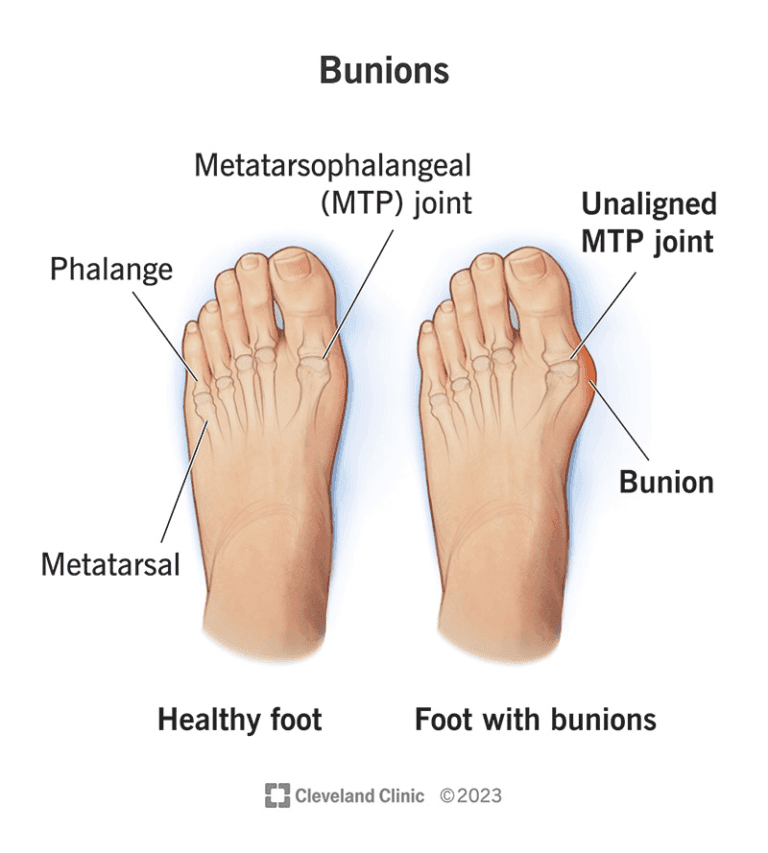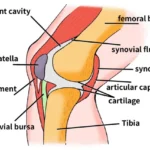Bunions are a common and often painful foot condition characterised by a bony bump that develops inside the foot at the big toe joint. This condition is frequently associated with hallux valgus, a deformity where the big toe drifts towards the smaller toes and the outside of the foot. This drift causes a significant alteration in the foot’s mechanics, leading to discomfort and difficulty in walking.
What Causes Bunions?
Bunions develop gradually due to prolonged pressure on the big toe joint. This pressure causes the big toe to lean towards the second toe, shifting the normal position of the bones, tendons, and ligaments and resulting in the bunion deformity. Several factors contribute to bunion development:
- Poorly Fitting Shoes:Wearing shoes that are too tight, narrow, or have high heels can force the toes into an unnatural position, promoting bunion formation.
- Genetics: Many people with bunions have a family history of the condition, indicating a genetic predisposition. This genetic component is particularly evident in adolescent bunions.
- Inflammatory Conditions:Diseases like rheumatoid arthritis can increase the risk of developing bunions by causing joint inflammation.
- Neuromuscular Conditions: Conditions such as Charcot-Marie-Tooth disease or polio can contribute to the development of bunions by affecting muscle and nerve function.
Anatomy of a Bunion
The big toe consists of two joints, the largest of which is the metatarsophalangeal (MTP) joint, where the metatarsal bone meets the first bone of the toe (phalanx). Bunions form when these bones move out of alignment. Specifically, the metatarsal bone shifts towards the inside of the foot, and the phalanx bones angle towards the second toe. This misalignment causes the MTP joint to enlarge and protrude, often inflamed due to abnormal mechanics and direct irritation from footwear.
Symptoms of Bunions
Bunions are typically characterised by a noticeable bump on the inside of the foot at the base of the big toe. Other common symptoms include:
- Pain and Tenderness: Often felt over the bony bump, especially when wearing tight or narrow shoes.
- Redness and Inflammation: Due to irritation and friction from shoes.
- Hardened Skin May develop on the bottom of the foot due to altered walking mechanics.
- Callus or Corn: Forming on the bump where it rubs against shoes.
- Stiffness and Restricted Motion in the big toe can lead to difficulty walking and performing everyday activities.
Bunion Progression and Related Foot Problems
Bunions typically start small but can worsen over time. As the bunion enlarges, it can significantly alter the appearance and function of the foot. Severe bunions may cause the big toe to angle under or over the second toe, potentially leading to additional foot problems, such as:
- Hammer Toe Deformities: Where the second, third, or fourth toes become bent at the middle joint, causing pain and difficulty in wearing shoes.
- Calluses: May develop where the toes rub against each other, causing additional discomfort.
- Bursitis: An inflammation of the fluid-filled sac (bursa) that cushions the joint, leading to chronic pain and arthritis if left untreated.
In some cases, the enlarged MTP joint can lead to chronic pain and arthritis if the smooth articular cartilage covering the joint becomes damaged.
Adolescent Bunions
Adolescent bunions occur in young people, typically girls between 10 and 15. Unlike adult bunions, which often restrict joint motion, adolescent bunions generally allow normal big-toe movement.
they can still cause significant pain and difficulty in wearing shoes. It is essential to manage adolescent bunions carefully to prevent them from worsening and causing long-term foot problems.
Bunionette
A bunionette, or “tailor’s bunion,” forms on the outside of the foot near the base of the little toe. Like bunions, bunionettes can cause painful bursitis and calluses over the bump, making it difficult to wear specific shoes.
Diagnosing Bunions
Diagnosing bunions typically involves a physical examination of the foot and an assessment of the patient’s medical history. Doctors will often order X-rays to:
- Check the Alignment of the Toes: X-rays can show how far the bones have moved out of place.
- Look for Joint Damage or Arthritis: X-rays can reveal any damage to the MTP joint or if arthritis is present.
- Determine the Severity of the Bunion: This helps in planning the best treatment approach.
The X-ray images are usually taken while the patient stands to provide a clear view of the foot’s alignment.
Nonsurgical Treatment
In most cases, bunions can be managed without surgery. While nonsurgical treatments cannot reverse a bunion, they can alleviate pain and prevent the condition from worsening.
Standard nonsurgical treatment options include:
1. Changes in Footwear
- Properly Fitting Shoes: Wear shoes with a wide or open-toe box that fits correctly to avoid compressing the toes. Shoes with good arch support and cushioning can also help.
- Shoe Modifications: Use a shoe stretcher to alleviate pressure on the bunion or modify shoes to accommodate the bunion.
2. Padding
- Protective Silicone Pads: Worn inside the shoe, these pads can cushion the painful area. It is essential to test pads briefly to ensure they do not increase pressure on the bunion.
3. Orthotics and Other Devices
- Shoe Inserts (Orthotics): Over-the-counter or custom-made orthotics can help distribute pressure away from the bunion.
- Toe Spacers: These can help maintain proper alignment of the toes.
- Night Splints: These may alleviate pain by keeping the big toe straight, though they are not a permanent fix for bunions.
4. Medications
- Nonsteroidal Anti-Inflammatory Drugs (NSAIDs): Medications like ibuprofen and naproxen can reduce pain and swelling.
- Other Medications: Additional medications may be prescribed to manage pain and inflammation for bunions caused by arthritis.
Tips for Proper Shoe Fit
Choosing the right shoes is crucial for managing bunion pain. Here are some tips:
- Wide Insteps and Broad Toe Boxes:Shoes with these features provide ample room for the toes and reduce pressure on the bunion.
- Soft Soles and Stability:Look for shoes with soft, cushioned soles that provide good support.
- Avoid Tight, Short, or Pointed Shoes:These shoes can exacerbate bunion pain and worsen the condition.
- Heels No Higher Than Two Inches: Higher heels put more pressure on the forefoot and can increase the risk of foot problems.
- Measure Your Feet Regularly: The size of your feet changes as you age, so it is essential to measure them regularly to ensure a proper fit.
- Fit Shoes to the Largest Foot: Most people have one foot more significant than the other. Fit shoes to the larger foot.
- Fit Shoes at the End of the Day: Feet tends to swell throughout the day, so it is best to try on shoes in the evening when your feet are at their largest.
- Stand and Walk in the Shoes: Ensure adequate space (3/8″ to 1/2″) for your longest toe, and walk around to ensure the shoes fit comfortably.
When to Consider Bunion Surgery
Surgery may be necessary if pain and difficulty walking persist despite nonsurgical treatments. Bunion surgery aims to relieve pain by realigning the bone, ligaments, tendons, and nerves. There are various surgical options, ranging from minor procedures for mild bunions to more extensive surgeries for severe cases. Typically, bunion surgery is a same-day procedure with no hospital stay, but recovery can be lengthy.
1. Types of Bunion Surgery
- Osteotomy: The surgeon cuts and realigns the bone. Pins, screws, or plates may be used to hold the bone in place.
- Exostectomy: The surgeon removes the bony bump from the toe joint. This procedure is often combined with osteotomy.
- Arthrodesis: The surgeon removes the arthritic joint surfaces and inserts screws, wires, or plates to hold the joint together until the bones heal. This procedure is typically reserved for severe bunions or when previous bunion surgeries have failed.
2. Recovery from Bunion Surgery
- Weight Bearing: Depending on the type of surgery, patients may be able to bear weight on the foot using a stiff-soled shoe immediately after surgery, or they may need a short period of immobilisation without weight bearing.
- Rehabilitation:Physiotherapy may be recommended to improve the foot’s strength and range of motion.
- Pain Management: Medications and ice may be used to manage pain and swelling.
Adolescent bunion surgery is generally avoided unless the bunion causes extreme pain and does not respond to other treatments, as there is a risk of the bunion returning, mainly if performed before skeletal maturity.
Conclusion
Bunions can cause significant discomfort and affect daily activities. Understanding the causes, symptoms, and treatment options can help manage the condition effectively.
Proper management can alleviate pain and improve quality of life, whether through nonsurgical methods or, in severe cases, surgical intervention. If you suspect you have a bunion, consult with a healthcare professional for an accurate diagnosis and personalised treatment plan.
By being proactive and addressing bunions early, you can maintain better foot health and avoid the complications of this joint foot deformity. Remember, proper footwear, early intervention, and regular monitoring are crucial to managing bunions effectively.







